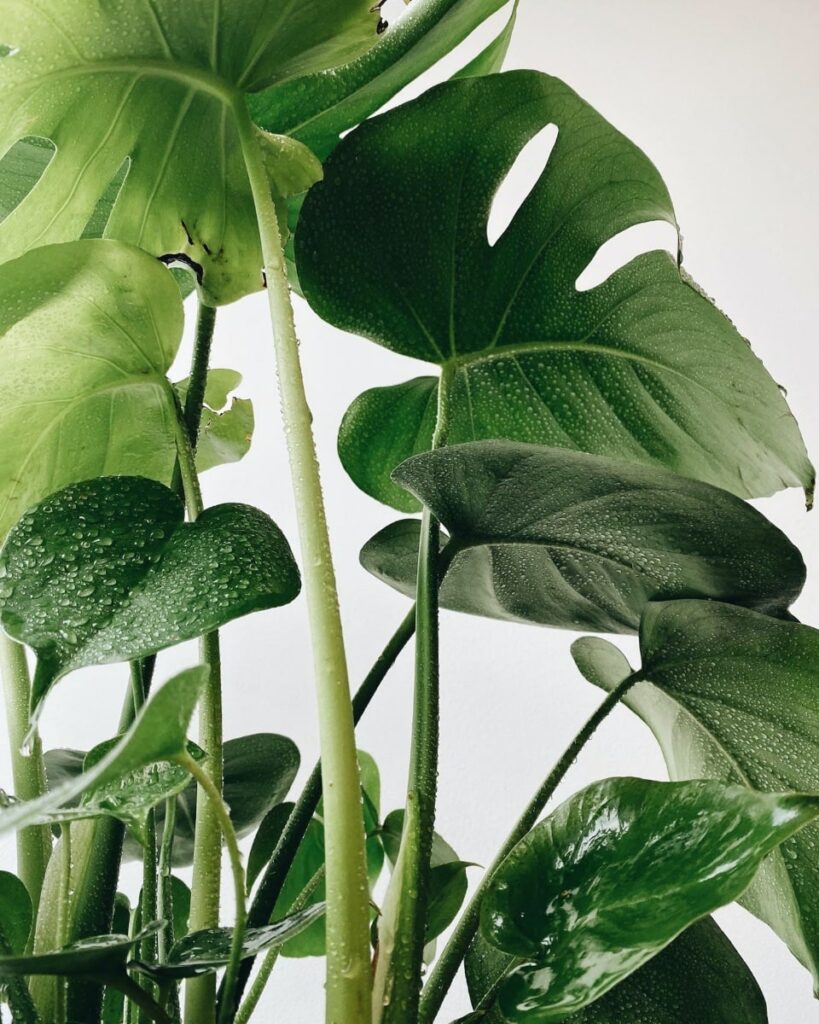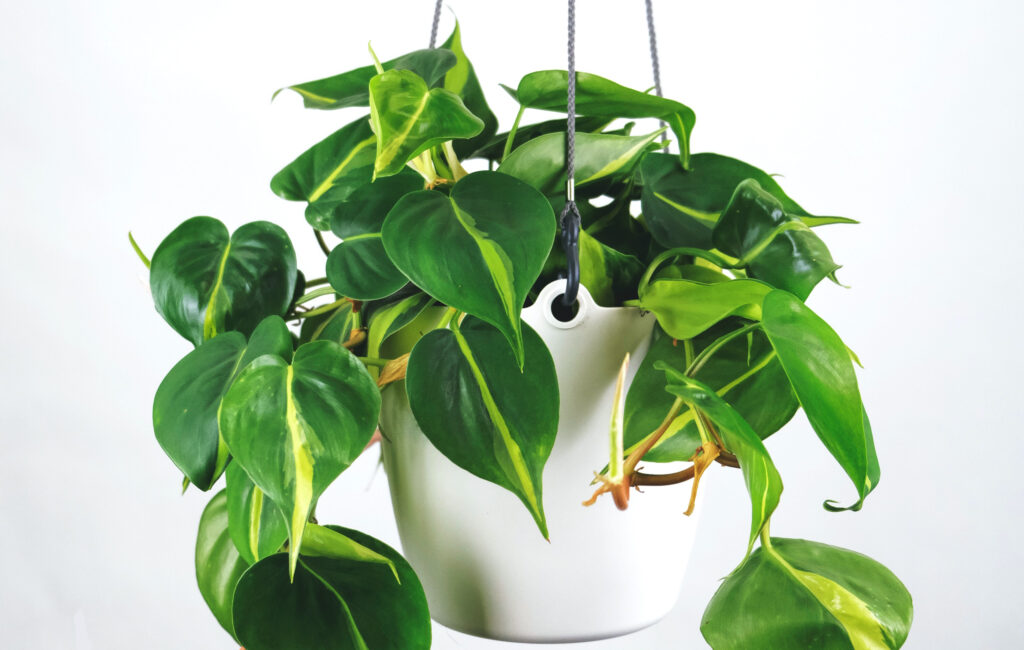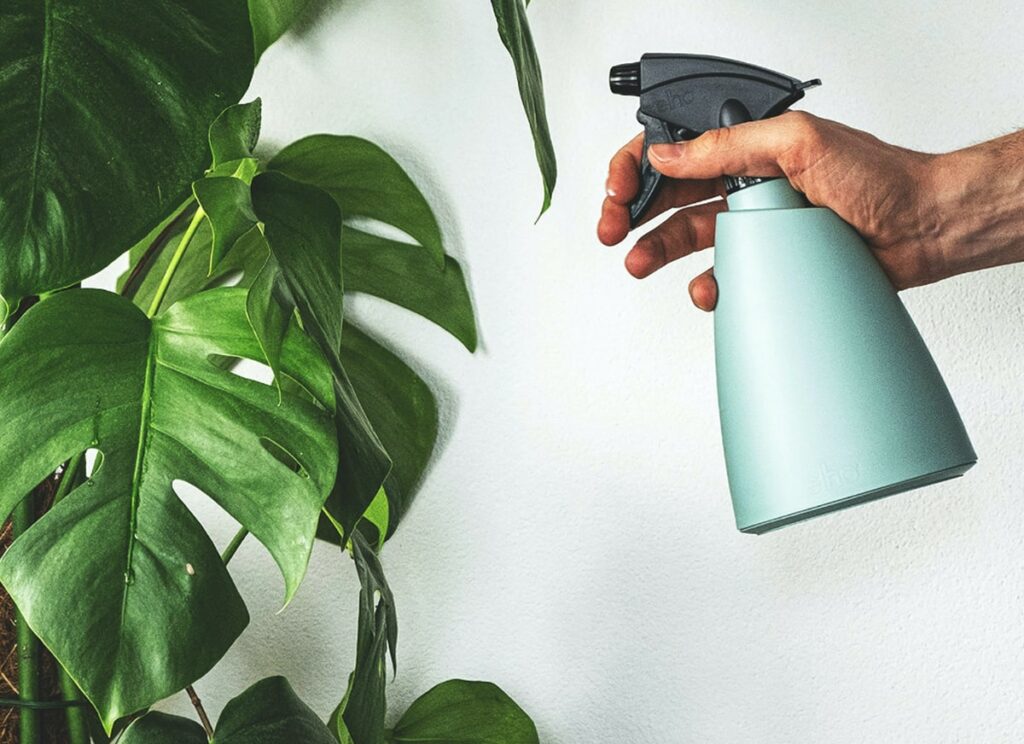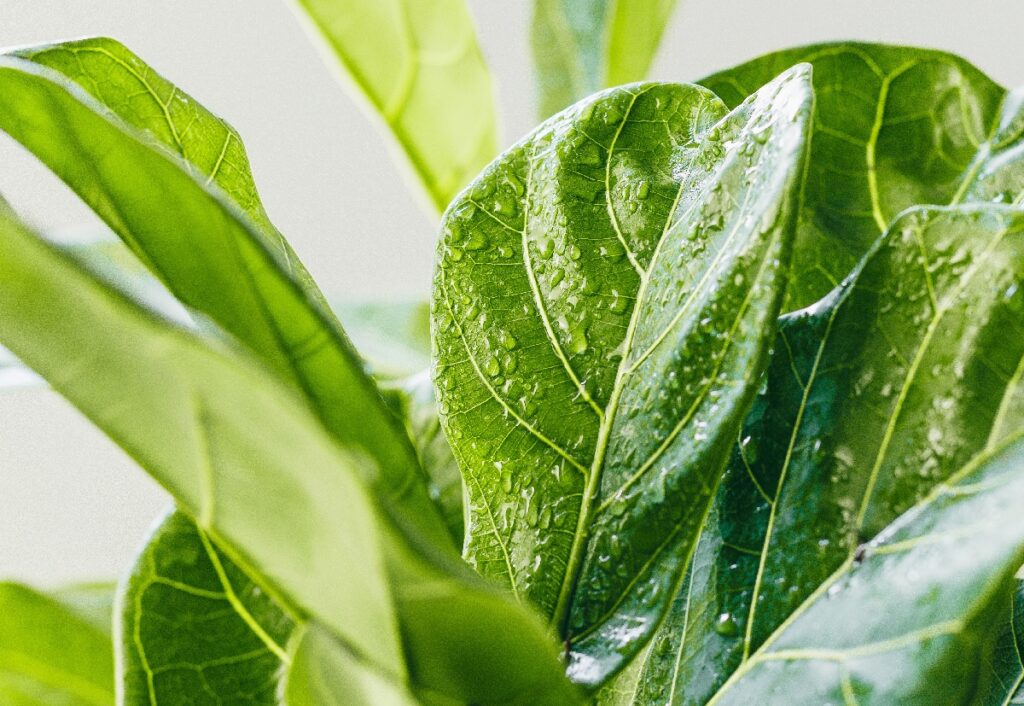The task of cleaning plant leaves is of utmost importance for every plant owner. The leaves of plants are the primary organs responsible for the process of photosynthesis, which involves the conversion of light energy into chemical energy. However, when the leaves are dirty, they cannot perform this function efficiently, leading to a decrease in plant growth and health. Let’s review the importance clean leaves provide to your plant, and the absolute best ways on how to clean plant leaves to encourage health and growth.
The accumulation of dust, dirt, and other debris on the surface of plant leaves can block the pores, preventing the exchange of gases between the plant and the environment. This can lead to a buildup of carbon dioxide, which can be harmful to the plant. Moreover, dirty leaves can attract pests and diseases, causing further damage to the plant.
Cleaning plant leaves not only helps to improve the appearance of the plant but also restores its natural shine and vibrancy, making it more appealing to the eye. By regularly cleaning the leaves, you can also identify any problems with your plant early on. By inspecting the leaves closely, you can spot any signs of pests, diseases, or nutrient deficiencies before they become severe, enabling you to take corrective action quickly and prevent further damage to the plant.
Cleaning plant leaves is an essential task that can help to improve the health and appearance of your plants. By removing dust, dirt, and debris from the leaves, you can ensure that they can perform their vital functions efficiently, prevent pest and disease infestations, and identify any problems early on.
Tools and materials needed for cleaning plant leaves
To embark on the task of cleaning your plant leaves, it is imperative that you first gather the necessary tools and materials. The complexity of this task cannot be overstated, and it is important to approach it with the right mindset. Here are the items that you will need to ensure that your plant leaves are cleaned to perfection:
1. Soft cloth or sponge: The choice of cloth or sponge is of utmost importance. You must choose a soft cloth or sponge that will not cause any damage to the delicate surface of your plant leaves. It is imperative that you avoid using rough materials like paper towels or abrasive sponges, as they can cause irreparable damage. Microfiber cloths work great for delicate plant leaves and are readily available from online retailers or local stores.
2. Water: The importance of clean, lukewarm water cannot be overstated. You will need this to moisten your cloth or sponge and rinse off any dirt or debris from the leaves. The temperature of the water is crucial, as using water that is too hot or too cold can cause damage to your plants.
3. Spray bottle: A spray bottle can be an invaluable tool when it comes to cleaning your plant leaves. It can be used to mist the leaves with water before cleaning, which can help to loosen any dirt or dust and make it easier to wipe away. This is a crucial step in the cleaning process, and should not be overlooked.
4. Mild soap: If your plant leaves are particularly dirty or have sticky residue on them, you may need to use a mild soap solution to clean them. It is important to choose a gentle, plant-based soap that will not harm your plants. This is a delicate process, and should be approached with care.
5. Pruning shears: While cleaning your plant leaves, you may notice that some of them are dead or damaged. In such cases, it may be necessary to use pruning shears to remove them. This can help to keep your plant healthy and promote new growth. It is important to approach this step with caution, as using the wrong tools or techniques can cause more harm than good.
By gathering these tools and materials before you start cleaning your plant leaves, you can ensure that the process goes smoothly and your plants stay healthy and happy. This is a task that requires a great deal of attention to detail, and should not be taken lightly.
How to clean plant leaves: step-by-step guide

The process of cleaning plant leaves is a crucial aspect of plant care that cannot be overlooked. Accumulated dust, dirt, and grime can block sunlight and reduce the plant’s ability to photosynthesize.
Step 1: Identify the type of plant
Before embarking on the cleaning process, it is essential to identify the type of plant you have. Some plants are sensitive to water, and their leaves can get damaged if they get wet. Conversely, others can tolerate water and require frequent misting. Knowing your plant’s needs will help you determine the best cleaning method.
Step 2: Dust off the leaves
The first step in cleaning plant leaves is to remove any dust or debris that has accumulated on them. You can use a soft-bristled brush or a microfiber cloth to gently wipe the leaves. Be careful not to rub too hard, as this can damage the leaves. A gentle touch is key.
Step 3: Prepare the cleaning solution
Next, prepare a cleaning solution. You can use a mild soap or a plant-specific cleaning solution. Mix the solution with water in a spray bottle. Be sure to follow the instructions on the label carefully. A precise measurement is crucial.
Step 4: Apply the cleaning solution
Spray the cleaning solution onto the leaves, making sure to cover both sides. Be careful not to saturate the leaves, as this can cause damage. If you are cleaning a large plant, you may need to work in sections. A strategic approach is necessary.
Step 5: Wipe the leaves
After applying the cleaning solution, use a clean, damp cloth to wipe the leaves gently. Be sure to remove any soap residue. If you are cleaning a large plant, you may need to use several cloths. A thorough cleaning is essential.
Step 6: Rinse the leaves
If your plant can tolerate water, you can rinse the leaves with clean water to remove any remaining soap residue. Be sure to use room temperature water, as cold water can shock the plant. A careful approach is necessary.
Step 7: Dry the leaves
Finally, use a clean, dry cloth to gently pat the leaves dry. Be sure to remove any excess water, as this can cause damage to the plant. A gentle touch is key.
Cleaning plant leaves is an essential part of plant care that requires a strategic and precise approach. By following these simple steps, you can keep your plants healthy and looking their best. Remember to always check the plant’s needs before cleaning and to be gentle when wiping the leaves. Happy cleaning!
Tips for cleaning specific types of plant leaves

The cleaning of plant leaves is a task that requires a certain level of expertise, as different types of plants have different types of leaves, and therefore, require different cleaning methods. Here are some tips for cleaning specific types of plant leaves that will help you to keep your plants looking their best and thriving.
For plants with smooth leaves, such as Fiddle Leaf Figs, rubber plants and peace lilies, can be wiped down with a damp cloth or sponge. However, it is important to use lukewarm water and avoid getting water on the soil to prevent any damage.
Plants that have fuzzy leaves, such as African violets and begonias, should be cleaned with a soft-bristled brush or a feather duster. It is crucial to avoid getting water on the leaves, as it can damage the fuzz and cause harm to the plant.
Plants with large leaves, such as elephant ears and philodendrons, can be cleaned with a damp cloth or sponge. However, it is essential to support the leaves with one hand while cleaning with the other to avoid tearing.
Ferns can be cleaned by misting them with water or by placing them in the shower for a gentle rinse. It is important to drain excess water from the pot after cleaning to prevent any damage.
Succulents should be cleaned with a soft-bristled brush or a feather duster. It is crucial to avoid getting water on the leaves, as it can cause rot and harm to the plant.
It is important to always be gentle when cleaning plant leaves, as they can be delicate and easily damaged. Regular cleaning will not only keep your plants looking their best, but it will also help them to thrive.
Common mistakes to avoid when cleaning plant leaves
When it comes to the task of cleaning plant leaves, there are a plethora of common mistakes that people tend to make. These mistakes can be detrimental to the health of your plants and can cause irreparable damage to their leaves. In order to avoid these pitfalls, it is important to be aware of the following common mistakes:
1. Using harsh chemicals: One of the most common mistakes that people make when cleaning plant leaves is using harsh chemicals. This can be incredibly harmful to the plant and can cause significant damage to the leaves. Instead, it is recommended that you use a gentle, natural cleaner such as water or a mild soap solution.
2. Using too much water: Another common mistake is using too much water when cleaning plant leaves. This can lead to overwatering and can cause the plant to become waterlogged. To avoid this, it is best to use a spray bottle or a damp cloth to gently clean the leaves.
3. Cleaning in direct sunlight: Cleaning plant leaves in direct sunlight can be a recipe for disaster. This can cause the leaves to burn and become damaged. To avoid this, it is best to clean your plants in a shaded area or during the early morning or late afternoon when the sun is not as strong.
4. Using a rough cloth: Using a rough cloth to clean plant leaves can cause scratches and damage to the leaves. Instead, it is recommended that you use a soft cloth or a sponge to gently wipe the leaves clean.
By avoiding these common mistakes, you can ensure that your plants remain healthy and their leaves remain clean and vibrant. So, take heed of these tips and keep your plants looking their best!
How often should you clean your plant leaves?
The act of cleaning your plant leaves is a crucial component of plant care. Not only does it enhance the aesthetic appeal of your plants, but it also facilitates their ability to breathe and absorb nutrients. However, the question remains: how often should you clean your plant leaves? The answer to this inquiry is contingent upon several factors.
Primarily, the type of plant you possess will dictate the frequency at which you should clean its leaves. Certain plants, such as succulents, possess waxy leaves that repel dust and dirt, thereby necessitating less frequent cleaning. Conversely, plants with large, broad leaves, such as the Fiddle Leaf Fig, are more susceptible to accumulating dust and should be cleaned more frequently.
Secondarily, the environment in which your plant is situated will also impact the frequency at which you should clean its leaves. If your plant is located in a dusty or humid area, it will require more frequent cleaning. Similarly, if your plant is situated near a window or in an area with high air circulation, it may accumulate more dust and necessitate more frequent cleaning.
In general, it is recommended to clean your plant leaves once a month. This will aid in keeping them free from dust and dirt, and ensure that they are able to absorb sunlight and nutrients efficiently. However, if you observe that your plant’s leaves are particularly dirty or dusty, you may need to clean them more frequently.
Cleaning your plant leaves is a vital aspect of plant care, and the frequency at which you should clean them is contingent upon the type of plant and its environment. By regularly cleaning your plant leaves, you can promote the health and aesthetic appeal of your plants.
Alternative methods for cleaning plant leaves

When it comes to cleaning plant leaves, the traditional method of using a damp cloth or sponge may not always be the best option. Luckily, there are alternative methods that can be just as effective. Here are a few options to consider:
1. Spray Bottle: A spray bottle filled with water can be a great way to mist the leaves of your plants. This method is particularly useful for plants with delicate leaves that may be damaged by wiping them with a cloth.
2. Feather Duster: A feather duster can be a gentle way to remove dust and debris from plant leaves. Simply run the feather duster over the leaves, being careful not to apply too much pressure.
3. Soft-Bristled Brush: A soft-bristled brush, such as a paintbrush or makeup brush, can be used to gently brush away dust and debris from plant leaves. This method is particularly useful for plants with small leaves or intricate foliage.
4. Shower: For larger plants that are difficult to move, consider taking them into the shower for a quick rinse. Be sure to use lukewarm water and avoid getting the soil too wet.
No matter which method you choose, it is important to avoid using any harsh chemicals or cleaning products on your plants, as these can damage the leaves and harm the plant. Stick to gentle, natural methods to keep your plants looking their best.
Troubleshooting: What to do if your plant leaves are still dirty

Despite your best efforts, you may find that your plant leaves are still dirty even after cleaning them. But fret not, there are a few things you can do to troubleshoot the issue.
First and foremost, it is imperative to ensure that you are using the right cleaning method for your plant. Some plants are more delicate than others and may require a gentler approach. If you are using a harsh cleaning solution or scrubbing too hard, you may be damaging the leaves and making it harder to remove dirt and grime.
Second, it is crucial to check the environment your plant is in. If your plant is located in a dusty or dirty area, it may be difficult to keep the leaves clean. Consider moving the plant to a cleaner location or using a dust cover to protect the leaves.
Third, it is essential to inspect the leaves closely to see if there are any pests or diseases present. If you notice any signs of infestation or illness, you may need to take additional steps to treat the problem before attempting to clean the leaves.
Last but not least, patience is key. Sometimes it takes a few attempts to get your plant leaves completely clean. If you are still having trouble, try a different cleaning method or consult with a plant expert for advice. With a little persistence and care, you can keep your plant leaves looking healthy and vibrant.
Frequently Asked Questions
How often should I clean my plant leaves?
It is recommended to clean your plant leaves once a month to remove dust and debris that can block sunlight and hinder photosynthesis. However, if you notice your plant leaves are particularly dirty or dusty, you can clean them more frequently.
What is the best way to clean plant leaves?
The best way to clean plant leaves is to use a soft, damp cloth or sponge. You can also use a spray bottle filled with water to mist the leaves and then gently wipe them with a cloth. Avoid using harsh chemicals or cleaning products as they can damage the leaves.
Can I use soap to clean my plant leaves?
It is not recommended to use soap to clean plant leaves as it can leave a residue that can clog the pores of the leaves and hinder photosynthesis. Stick to using plain water or a mild, plant-based cleaner if necessary.
Should I clean both sides of the plant leaves?
Yes, it is important to clean both sides of the plant leaves to ensure they are free of dust and debris. This will allow the leaves to absorb sunlight and perform photosynthesis more efficiently.
Can I use a leaf shine product to clean my plant leaves?
It is not recommended to use leaf shine products to clean plant leaves as they can clog the pores of the leaves and hinder photosynthesis. Stick to using plain water or a mild, plant-based cleaner if necessary.

